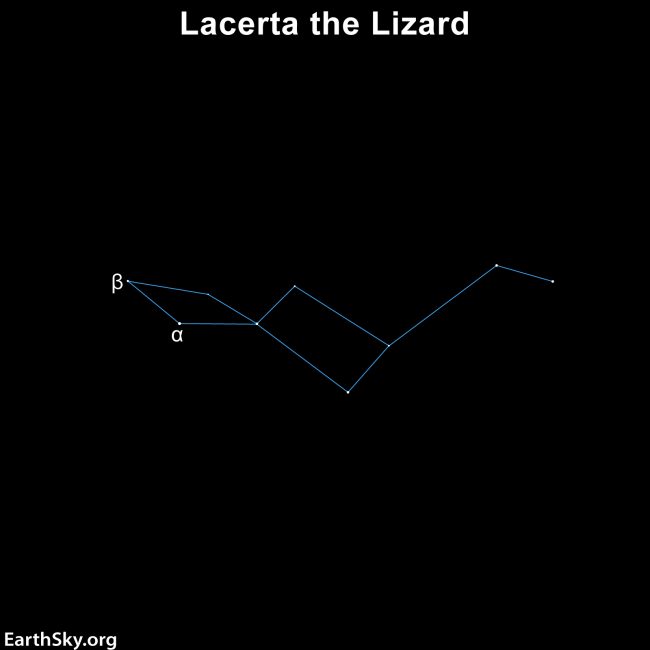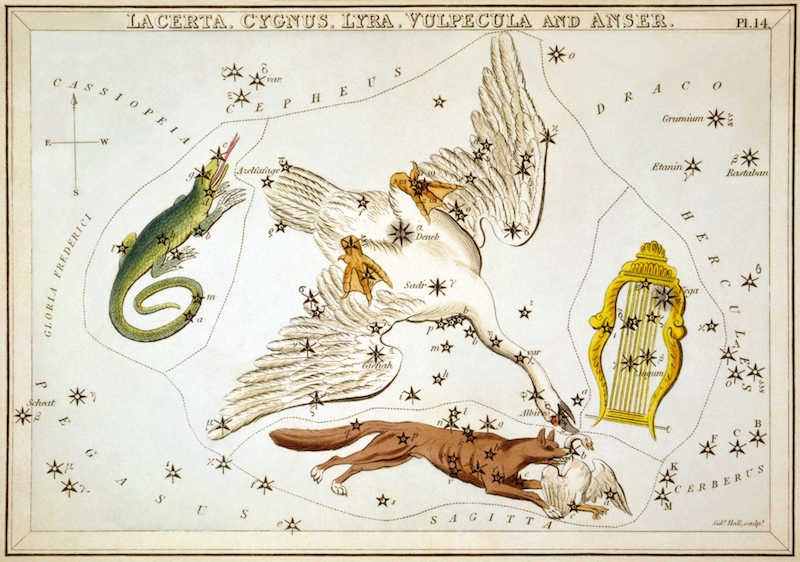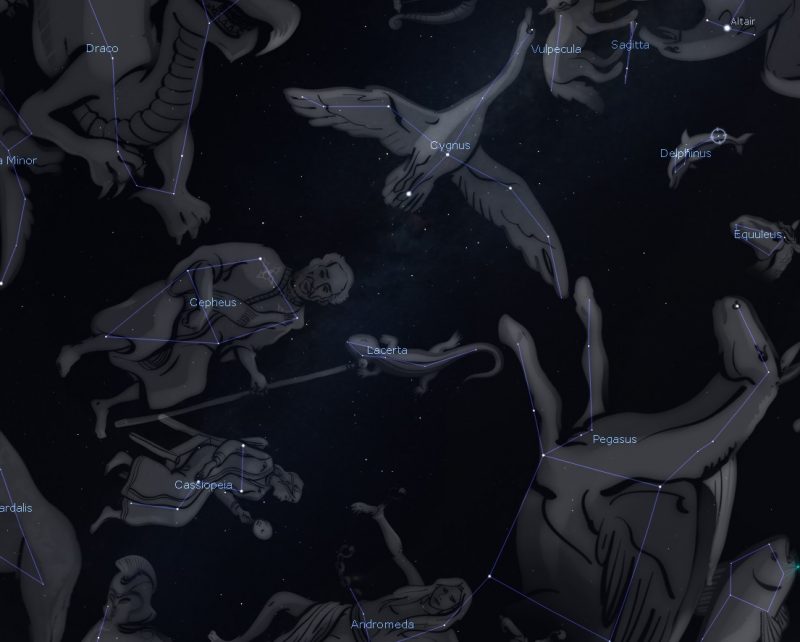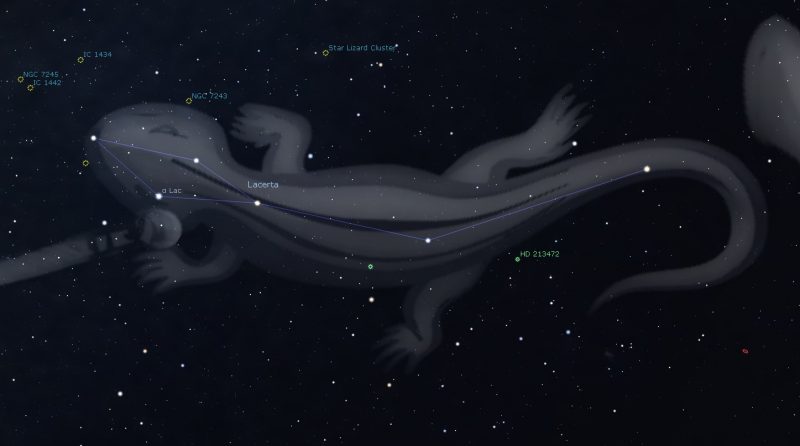
The constellation of Lacerta the Lizard is a mostly dark patch of sky only observable to people in the Northern Hemisphere. While some parts of the lizard remain above the horizon all year long, you can see the entire constellation best in the autumn when it rises highest above the horizon. Lacerta is not an ancient constellation. In the late 1600s, astronomer Johannes Hevelius created this constellation out of a rather empty patch of sky. Lacerta is the word for lizard in Latin.
Finding the constellation of Lacerta the Lizard

Lacerta lies in the fall sky in the Northern Hemisphere. Look for it in the evenings after it has grown nice and dark so that you can spot its dim stars. Do you know how to spot the Great Square of Pegasus, the W-shaped Cassiopeia, the house-shaped Cepheus or Cygnus the Swan? If you do, you have it surrounded. These four constellations box in the dark region of sky where Lacerta lies.
Some people refer to Lacerta as the “little W,” due to its W-like shape. The “big W” is, of course, Cassiopeia. Can you see the Big and Little Ws next to each other in the sky? Others see Lacerta in the shape of a skinny kite. Perhaps you can actually spot the form of a lizard among its stars.
Lacerta is a fairly small constellation, only taking up 200 square degrees in size. It’s the 68th smallest constellation out of the 88 constellations.

The stars of the lizard
Only one star within the constellation’s borders is brighter than magnitude 4. This star is the magnitude 3.76 Alpha Lacertae. There are no named stars in Lacerta, only Greek letter designations. Alpha Lacertae lies 102 light-years away. Find it by using the top two stars in the top of the right “V” in Cassiopeia and extend that line toward Cygnus. Alpha Lacertae lies 16 and a half degrees from the W in Cassiopeia.
4th magnitude stars lie on all sides of Alpha Lacertae. The star in the direction of Polaris from Alpha Lacertae is Beta Lacertae. It is the only other Greek-designated star. The rest have numerical designations. Beta Lacertae is magnitude 4.42 and lies 170 light-years away.
Too dim for amateur astronomers to see, BL Lacertae is nonetheless an interesting object in Lacerta. It has a whole class of objects named for it, the BL Lacertae objects. BL Lacertae looks like a dim variable stars. It varies between magnitude 14 and 17 over the course of a few days. But upon inspection, scientists found that it’s an active galactic nucleus. BL Lacertae objects are also a type of blazar, or an active galactic nucleus with a jet that is directed toward Earth.
Star clusters in Lacerta

The majority of the constellation Lacerta lies within the swath of the Milky Way. Yet, there are no Messier objects within it. The brightest star cluster in Lacerta is NGC 7243, which lies two-and-a-half degrees from Alpha Lacertae in the direction of Cygnus. NGC 7243 is magnitude 6.4, meaning that you can spot it in a pair of binoculars. It lies about 2,800 light-years away and displays some large foreground stars juxtaposed over the hazy Milky Way.
The next brightest cluster lies on the border of Cygnus and Lacerta. This cluster is magnitude 6.7 NGC 7209 and has the nickname the Star Lizard Cluster. This loose, spread out cluster lies a similar distance from Earth as NGC 7243.
Draw a line from Alpha through Beta Lacertae and extend it for an equal distance as Alpha and Beta are apart. You will arrive at two stars clusters, NGC 7245 and IC 1442. IC 1442 is 9th magnitude and NGC 7245 is magnitude 9.19, therefore they are best viewed through a telescope. This pair lies only 20 arcminutes apart.
New exoplanet in Lacerta the Lizard
In 2021, scientists discovered an exoplanet in Lacerta: HD 213472 b. This gas giant planet is about 3 and a half times the mass of Jupiter and is 13 astronomical units (AU) from its parent star (compared to Jupiter’s 5 AU from the sun). It takes this planet 46.6 Earth years to make one orbit. The exoplanet and its star lie 210 light-years from Earth.
Bottom line: Lacerta the Lizard is a small, dim constellation in the fall sky that contains a blazar, or an active galactic nucleus with a jet pointed toward Earth.
The post Lacerta the Lizard, home to a blazar first appeared on EarthSky.
from EarthSky https://ift.tt/3A14aNa

The constellation of Lacerta the Lizard is a mostly dark patch of sky only observable to people in the Northern Hemisphere. While some parts of the lizard remain above the horizon all year long, you can see the entire constellation best in the autumn when it rises highest above the horizon. Lacerta is not an ancient constellation. In the late 1600s, astronomer Johannes Hevelius created this constellation out of a rather empty patch of sky. Lacerta is the word for lizard in Latin.
Finding the constellation of Lacerta the Lizard

Lacerta lies in the fall sky in the Northern Hemisphere. Look for it in the evenings after it has grown nice and dark so that you can spot its dim stars. Do you know how to spot the Great Square of Pegasus, the W-shaped Cassiopeia, the house-shaped Cepheus or Cygnus the Swan? If you do, you have it surrounded. These four constellations box in the dark region of sky where Lacerta lies.
Some people refer to Lacerta as the “little W,” due to its W-like shape. The “big W” is, of course, Cassiopeia. Can you see the Big and Little Ws next to each other in the sky? Others see Lacerta in the shape of a skinny kite. Perhaps you can actually spot the form of a lizard among its stars.
Lacerta is a fairly small constellation, only taking up 200 square degrees in size. It’s the 68th smallest constellation out of the 88 constellations.

The stars of the lizard
Only one star within the constellation’s borders is brighter than magnitude 4. This star is the magnitude 3.76 Alpha Lacertae. There are no named stars in Lacerta, only Greek letter designations. Alpha Lacertae lies 102 light-years away. Find it by using the top two stars in the top of the right “V” in Cassiopeia and extend that line toward Cygnus. Alpha Lacertae lies 16 and a half degrees from the W in Cassiopeia.
4th magnitude stars lie on all sides of Alpha Lacertae. The star in the direction of Polaris from Alpha Lacertae is Beta Lacertae. It is the only other Greek-designated star. The rest have numerical designations. Beta Lacertae is magnitude 4.42 and lies 170 light-years away.
Too dim for amateur astronomers to see, BL Lacertae is nonetheless an interesting object in Lacerta. It has a whole class of objects named for it, the BL Lacertae objects. BL Lacertae looks like a dim variable stars. It varies between magnitude 14 and 17 over the course of a few days. But upon inspection, scientists found that it’s an active galactic nucleus. BL Lacertae objects are also a type of blazar, or an active galactic nucleus with a jet that is directed toward Earth.
Star clusters in Lacerta

The majority of the constellation Lacerta lies within the swath of the Milky Way. Yet, there are no Messier objects within it. The brightest star cluster in Lacerta is NGC 7243, which lies two-and-a-half degrees from Alpha Lacertae in the direction of Cygnus. NGC 7243 is magnitude 6.4, meaning that you can spot it in a pair of binoculars. It lies about 2,800 light-years away and displays some large foreground stars juxtaposed over the hazy Milky Way.
The next brightest cluster lies on the border of Cygnus and Lacerta. This cluster is magnitude 6.7 NGC 7209 and has the nickname the Star Lizard Cluster. This loose, spread out cluster lies a similar distance from Earth as NGC 7243.
Draw a line from Alpha through Beta Lacertae and extend it for an equal distance as Alpha and Beta are apart. You will arrive at two stars clusters, NGC 7245 and IC 1442. IC 1442 is 9th magnitude and NGC 7245 is magnitude 9.19, therefore they are best viewed through a telescope. This pair lies only 20 arcminutes apart.
New exoplanet in Lacerta the Lizard
In 2021, scientists discovered an exoplanet in Lacerta: HD 213472 b. This gas giant planet is about 3 and a half times the mass of Jupiter and is 13 astronomical units (AU) from its parent star (compared to Jupiter’s 5 AU from the sun). It takes this planet 46.6 Earth years to make one orbit. The exoplanet and its star lie 210 light-years from Earth.
Bottom line: Lacerta the Lizard is a small, dim constellation in the fall sky that contains a blazar, or an active galactic nucleus with a jet pointed toward Earth.
The post Lacerta the Lizard, home to a blazar first appeared on EarthSky.
from EarthSky https://ift.tt/3A14aNa

Aucun commentaire:
Enregistrer un commentaire